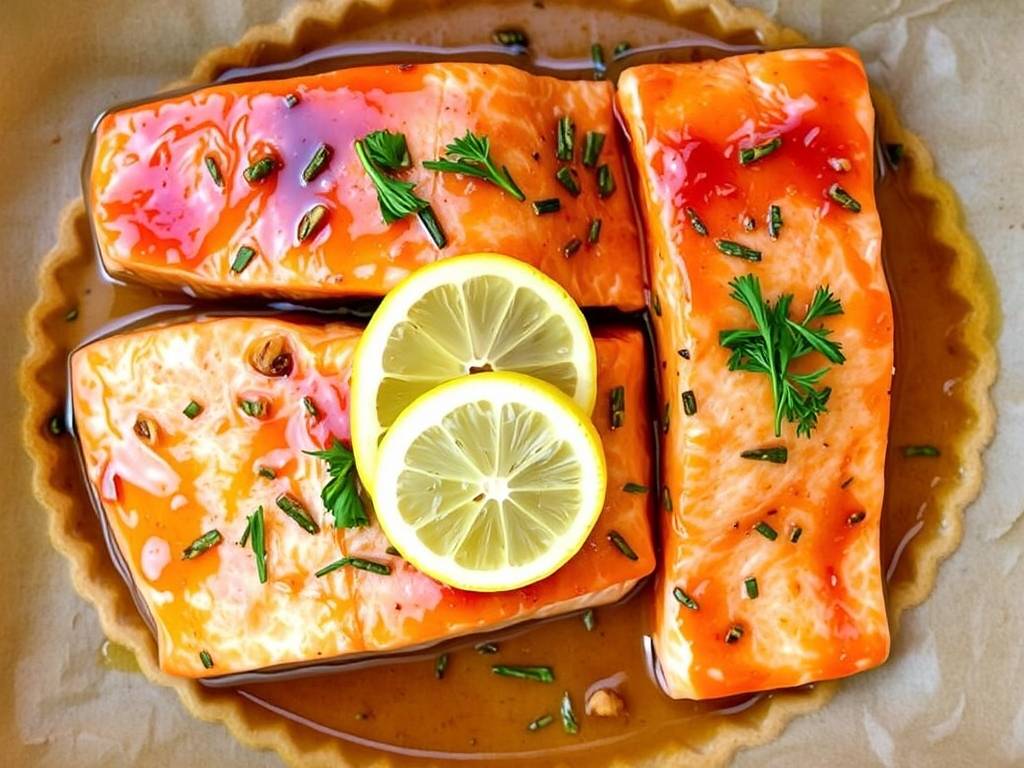Salmon is a versatile and nutritious fish that has earned its place as a staple in kitchens around the world. Its rich, buttery flavor and tender texture make it an ideal canvas for a variety of seasonings and cooking methods. Among the many ways to prepare salmon, baking it with a brown sugar and mustard glaze stands out as a particularly delightful option. This method combines the savory depth of mustard with the sweet caramelization of brown sugar, creating a dish that is both elegant and comforting. In this article, we will explore the step-by-step process of baking salmon with this irresistible glaze, along with tips for selecting the best ingredients, pairing suggestions, and variations to suit different tastes.
Why This Combination Works
The marriage of brown sugar and mustard might seem unconventional at first, but it is a pairing rooted in culinary tradition. The sweetness of the brown sugar balances the tanginess of the mustard, while both ingredients contribute to a beautiful caramelized crust on the salmon. Brown sugar, with its molasses content, adds a deep, rich sweetness that enhances the natural flavors of the fish. Mustard, on the other hand, provides a sharp, acidic contrast that cuts through the richness of the salmon. Together, they create a glaze that is complex, flavorful, and incredibly satisfying.
Selecting the Right Salmon
The foundation of any great salmon dish is, of course, the fish itself. When selecting salmon for baking, it is important to choose high-quality, fresh fillets. Look for salmon that has a vibrant pink or orange hue, depending on the variety, with firm, moist flesh. Avoid any fillets that appear dull, dry, or have a strong fishy odor, as these are signs of age or poor handling.

There are several types of salmon available, each with its own unique characteristics. Atlantic salmon is commonly farmed and has a mild flavor and tender texture, making it a popular choice for baking. Pacific salmon varieties, such as sockeye, coho, and king salmon, are often wild-caught and have a more robust flavor and firmer texture. For this recipe, any type of salmon will work, but keep in mind that wild-caught salmon may require slightly less cooking time due to its leaner composition.
If possible, opt for sustainably sourced salmon. Many grocery stores and fish markets now label their seafood with information about its origin and sustainability. Choosing responsibly sourced salmon not only supports healthy ocean ecosystems but also often results in a better-tasting product.
Preparing the Glaze
The glaze is the star of this dish, and making it is simple and straightforward. The basic ingredients include brown sugar, mustard, and a few complementary elements to enhance the flavor profile. Here is a standard recipe for the glaze:
- 1/4 cup brown sugar (packed)
- 2 tablespoons Dijon mustard
- 1 tablespoon whole-grain mustard
- 1 tablespoon olive oil
- 1 tablespoon lemon juice
- 1 clove garlic, minced
- 1/2 teaspoon smoked paprika (optional)
- Salt and pepper to taste
In a small bowl, combine the brown sugar, Dijon mustard, whole-grain mustard, olive oil, lemon juice, minced garlic, and smoked paprika if using. Whisk until the ingredients are well blended and the sugar has dissolved. The consistency should be thick but spreadable. If the glaze seems too thick, you can add a teaspoon of water or more lemon juice to thin it slightly. Season with salt and pepper to taste.
The type of mustard you use can influence the final flavor. Dijon mustard offers a smooth, sharp tang, while whole-grain mustard adds texture and a more rustic flavor. Feel free to experiment with other mustards, such as honey mustard or spicy brown mustard, to tailor the glaze to your preferences.
Preparing the Salmon
Before applying the glaze, the salmon needs to be prepared properly. Start by patting the fillets dry with paper towels. This step is crucial because it removes excess moisture, allowing the glaze to adhere better and promoting even cooking. If the salmon has skin, you can choose to leave it on or remove it. Leaving the skin on can help hold the fillet together during baking and can be easily removed after cooking if desired.
Place the salmon fillets on a baking sheet lined with parchment paper or aluminum foil. If using foil, lightly grease it with olive oil or cooking spray to prevent sticking. Arrange the fillets with some space between them to ensure they cook evenly.
Applying the Glaze and Baking
Preheat your oven to 400°F (200°C). Using a brush or spoon, generously coat the top of each salmon fillet with the glaze. Make sure to cover the entire surface, including the sides, for maximum flavor.
Bake the salmon for 12-15 minutes, depending on the thickness of the fillets. The salmon is done when it flakes easily with a fork and has an internal temperature of 145°F (63°C). For a more caramelized crust, you can switch the oven to broil for the last 2-3 minutes of cooking. Keep a close eye on the salmon during broiling to prevent burning.

Serving Suggestions
Baked salmon with brown sugar and mustard glaze pairs well with a variety of side dishes. The sweet and savory flavors of the glaze complement both light and hearty accompaniments. Here are a few ideas:
- Vegetables: Roasted asparagus, Brussels sprouts, or green beans make excellent choices. The caramelization from roasting echoes the glaze on the salmon.
- Grains: Quinoa, couscous, or wild rice can serve as a neutral base that absorbs the flavors of the dish.
- Salads: A fresh green salad with a citrus vinaigrette can provide a refreshing contrast to the rich salmon.
For a complete meal, consider serving the salmon with a glass of white wine, such as Sauvignon Blanc or Chardonnay, which complements the dish's balance of sweetness and acidity.
Variations and Customizations
One of the joys of this recipe is its adaptability. Here are a few ways to customize the glaze to suit your taste:
- Spicy Kick: Add a pinch of cayenne pepper or a few dashes of hot sauce to the glaze for a spicy twist.
- Herbaceous Notes: Incorporate fresh herbs like dill, thyme, or parsley into the glaze for an added layer of flavor.
- Citrus Zest: Add the zest of a lemon or orange to the glaze for a bright, citrusy note.
- Maple Syrup: Substitute part of the brown sugar with maple syrup for a different kind of sweetness.
Conclusion
Baking salmon with a brown sugar and mustard glaze is a simple yet impressive way to prepare this beloved fish. The combination of sweet and tangy flavors, along with the beautiful caramelized crust, makes for a dish that is sure to become a favorite in your culinary repertoire. Whether you are cooking for a weeknight dinner or a special occasion, this recipe offers a delicious and nutritious option that is both easy to make and deeply satisfying. So next time you find yourself with a beautiful piece of salmon, consider giving this glaze a try—you might just discover your new go-to way to enjoy this fantastic fish.






发表评论